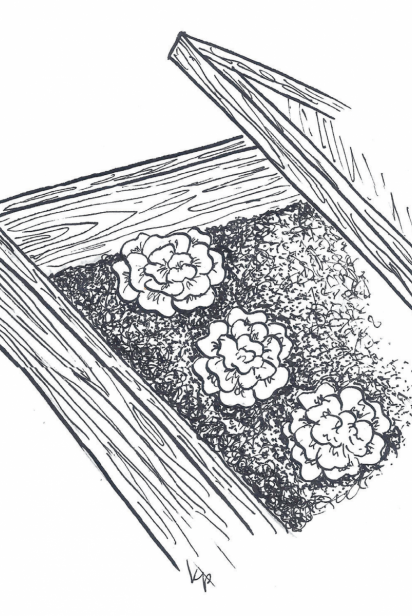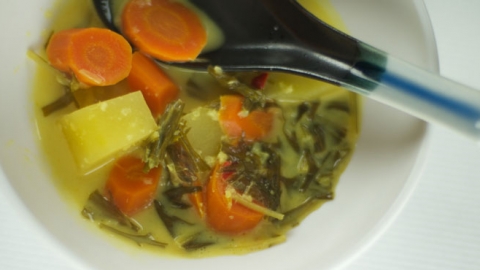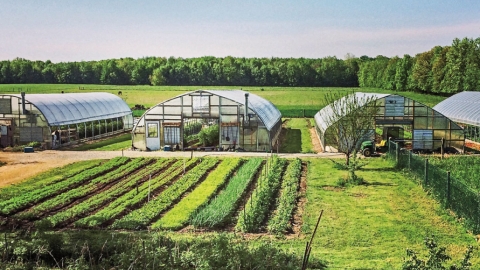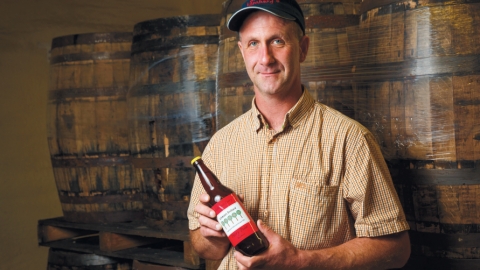Good Food Comes Full Circle
In August I was invited to join around 20 other growers with experience in winter growing for a two-day meeting in northern Vermont. The gathering was organized by Eliot Coleman, author, farmer and long-time sustainable farming advocate, who wanted to gather growers together to compare field notes on what has worked—and what hasn’t—in the winter.
Representatives from the University of Vermont and Cornell University, as well as seed company reps, were there to listen and share from their trials as well.
August is an odd month for a farm conference. Most farms, including ours, are bustling that time of year with tomatoes and peppers ripening fast, CSA boxes to fill, markets to attend. At first, I wasn’t sure I could go. In addition to the busy farm, my wife and I just celebrated the birth of our first child, Arlo; there was a lot keeping me rooted in Indiana.
But winter growing excites us, and in the end we decided the tomatoes can wait. I gave my wife and infant son a big smooch and boarded a plane for Burlington.
The Winter Food Challenge
Replacing apples from Chile and carrots from California is no small task, especially in the winter. According to author and food journalist Michael Pollan, how to produce enough food to feed our communities in the winter months is “the big question facing the local food movement.”
I love challenges, and the vision of a greenhouse full of leafy vegetables while eight inches of snow blanket the ground was part of what inspired me to start farming. On our farm, we have now been growing fresh food on the “back side of the calendar,” as Coleman refers to the months of November through March, for six years. We’ve developed techniques for keeping alive spinach, lettuces, kale, carrots and more, through the coldest, darkest parts of the year.
Still, after six years, we have a lot to learn. We’re at the tip of an iceberg. We’ve gained mastery on some five or six crops, but there are dozens—hundreds—of other varieties from all over the world that we’ve never tried, and many growing techniques we’ve never explored.
New Possibilities
I was picked up at the airport by Christa, one of the owners of Jericho Settlers Farm, one of the largest year-round organic vegetable and meat farms in Vermont. We rushed back to the farm, where I helped the farm crew unpack from a day of selling at several area farmers markets.
Like many farms in Vermont, Jericho Settlers is young and has grown fast. The farm was started in 2002 and has grown to a business that hires 15 employees and serves hundreds of customers. Vermont is a small state, the second least populated in the U.S., with just 600,000 residents—it’s about the size and population of Michiana— but there are more than 500 organic farms, including, as of 2009, 128 organic vegetable farms (Christa tells me the number now is closer to 200).
The state boasts the highest percentage of people buying locally grown food in the country. In 2009 there were 74 farmers markets in Vermont and 74 CSAs.
After helping the Jericho Settlers team for an afternoon, I spent the next two days in a room with 20-some other growers, comparing our technical notes about winter food production. Fifteen years ago, commercially grown greens and vegetables in winter months in the north was virtually unheard of; now there is a body of experience to learn from.
In particular, in just the past few years, small-scale and organic growers have experimented with a promising range of alternative and conventional heat sources (in-ground heat through buried water tubes, air heat from gas, convection heat using biomass boilers), layers of protection with new agricultural fabrics and plastics (greenhouses within a greenhouse) and countless new seed varieties developed specifically for winter production (finally, seed developers are listening to local growers and are breeding for flavor and winter hardiness as well as yield).
I heard from growers who, like us, continue to experiment with new types of greens— Chinese cabbage, winter-hardy kales, komatsunas and more— as well as new ways of growing shoots and microgreens. In addition, growers are improving storage practices in order to keep fall crops like carrots, sweet potatoes, leeks and butternut squash around until spring.
A Cooperative Effort
It’s one thing for growers to hone their skills at winter growing. Over time, growers will meet more challenges and production will increase. However, creating new markets needs to be part of the equation if small farms are to succeed and if local winter food is to become widely available all year round.
Reality is, the current shipped-from-far-away food system is propped up by subsidies—some argue that big ag is the most heavily subsidized industry in the U.S. As an industry, that system is no more economically sustainable than local farms selling direct to customers (usually without government support). Big farming—and its dependence on lots of transportation—is simply the kind of agriculture our culture has chosen to support.
It’s possible—even fun—to support other types of farming, even in the winter. Wendell Berry says “eating is an agricultural act,” by which he means that the food we put in our mouths determines to a large extent how our land is used.
So try this: Find a local grower to supply you with a bushel each of winter squash, potatoes, sweet potatoes and beets—and discover creative and delicious ways to bake them all winter. Plant some kale in your backyard, cover it with a blanket or spare sheet of plastic on really cold nights and enjoy fresh greens very late into the year.
Schools and other culture-definers: Teach kids the joy of eating real food and provide local food on the cafeteria line.
On my way back to the airport, my host Christa asked if it would be OK to drop off a couple of organic vegetable deliveries to a food hub and directly to a few restaurants on the way to the airport. Her long list of local buyers was impressive.
She dropped me off about an hour before my flight, enough time to unwind and grab a bite to eat. I ordered a sandwich and greens at a local favorite, the Skinny Pancake (actually, the only restaurant option available: the Burlington airport is trying be “the most local airport eatery in modern history”). On the overhead menu, I saw Christa’s farm listed, as well as Pete’s Greens and the farm names of other new farmer friends I’d made, along with a big sign boasting, “Where good food comes full circle.”
This winter, I look forward to bringing a piece of that Vermont circle back to Michiana. See you at the farmers market!











